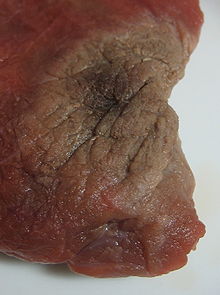Freezer burn: Difference between revisions
BoldBlueBike (talk | contribs) No edit summary |
BoldBlueBike (talk | contribs) No edit summary |
||
| Line 5: | Line 5: | ||
'''Freezer burn''' is a condition that occurs when frozen [[food]] has been damaged by dehydration and oxidation due to air reaching the food.<ref>{{cite news|url=https://www.loc.gov/rr/scitech/mysteries/freezerburn.html|title=What is 'freezer burn?'|work=Everyday Mysteries: Fun Science Facts from the Library of Congress|author=Library of Congress|url-status=live|archiveurl=https://web.archive.org/web/20070901055214/http://www.loc.gov/rr/scitech/mysteries/freezerburn.html|archivedate=2007-09-01}}</ref> It is generally caused by food not being securely wrapped in [[Vacuum packing|air-tight packaging]]. |
'''Freezer burn''' is a condition that occurs when frozen [[food]] has been damaged by dehydration and oxidation due to air reaching the food.<ref>{{cite news|url=https://www.loc.gov/rr/scitech/mysteries/freezerburn.html|title=What is 'freezer burn?'|work=Everyday Mysteries: Fun Science Facts from the Library of Congress|author=Library of Congress|url-status=live|archiveurl=https://web.archive.org/web/20070901055214/http://www.loc.gov/rr/scitech/mysteries/freezerburn.html|archivedate=2007-09-01}}</ref> It is generally caused by food not being securely wrapped in [[Vacuum packing|air-tight packaging]]. |
||
Freezer burn appears as grayish-brown leathery spots on frozen food and occurs when air reaches the food's surface and dries the product. Color changes result from chemical changes in the food's pigment. Freezer burn does not make the food unsafe; it merely causes dry spots in foods.<ref>{{cite web|website=USFDA |url=http://www.cfsan.fda.gov/~dms/qa-sto3.html |title=Does 'freezer burn' make food unsafe? |url-status=dead |archiveurl=https://web.archive.org/web/20080617154817/http://www.cfsan.fda.gov/~dms/qa-sto3.html |archivedate=June 17, 2008 }}</ref> The food remains usable and edible, but removing the freezer burns will improve the flavor. Also through sublimation, water is lost from the food into the surrounding atmosphere and the food becomes excessively dry. The water resublimates elsewhere in the food and packaging as snow-like crystals.<ref>{{Cite book |last=Heiss |first=Rudolf |url=https://www.worldcat.org/oclc/689919077 |title=Haltbarmachen von Lebensmitteln : chemische, physikalische und mikrobiologische Grundlagen der Verfahren |date=1990 |publisher=Springer |others=K. Eichner |isbn=978-3-662-07666-8 |edition=2., neubearbeitete und erw. Aufl |location=Berlin |oclc=689919077}}</ref> |
Freezer burn appears as grayish-brown leathery spots on frozen food and occurs when air reaches the food's surface and dries the product. Color changes result from chemical changes in the food's pigment. Freezer burn does not make the food unsafe; it merely causes dry spots in foods.<ref>{{cite web|website=USFDA |url=http://www.cfsan.fda.gov/~dms/qa-sto3.html |title=Does 'freezer burn' make food unsafe? |url-status=dead |archiveurl=https://web.archive.org/web/20080617154817/http://www.cfsan.fda.gov/~dms/qa-sto3.html |archivedate=June 17, 2008 }}</ref> The food remains usable and edible, but removing the freezer burns will improve the flavor. Also through sublimation, water is lost from the food into the surrounding atmosphere and the food becomes excessively dry. The water resublimates elsewhere in the food and packaging as snow-like crystals.<ref>{{Cite book |last=Heiss |first=Rudolf |url=https://www.worldcat.org/oclc/689919077 |title=Haltbarmachen von Lebensmitteln : chemische, physikalische und mikrobiologische Grundlagen der Verfahren |date=1990 |publisher=Springer |others=K. Eichner |isbn=978-3-662-07666-8 |edition=2., neubearbeitete und erw. Aufl |location=Berlin |oclc=689919077}}</ref><ref>{{Cite book |last=Buchner |first=Norbert |url=https://www.worldcat.org/oclc/913722328 |title=Verpackung von Lebensmitteln : Lebensmitteltechnologische, verpackungstechnische und mikrobiologische Grundlagen |date=1999 |isbn=978-3-642-58585-2 |location=Berlin, Heidelberg |oclc=913722328}}</ref> |
||
==See also== |
==See also== |
||
Revision as of 14:12, 30 September 2022

Freezer burn is a condition that occurs when frozen food has been damaged by dehydration and oxidation due to air reaching the food.[1] It is generally caused by food not being securely wrapped in air-tight packaging.
Freezer burn appears as grayish-brown leathery spots on frozen food and occurs when air reaches the food's surface and dries the product. Color changes result from chemical changes in the food's pigment. Freezer burn does not make the food unsafe; it merely causes dry spots in foods.[2] The food remains usable and edible, but removing the freezer burns will improve the flavor. Also through sublimation, water is lost from the food into the surrounding atmosphere and the food becomes excessively dry. The water resublimates elsewhere in the food and packaging as snow-like crystals.[3][4]
See also
References
Inline citations
- ^ Library of Congress. "What is 'freezer burn?'". Everyday Mysteries: Fun Science Facts from the Library of Congress. Archived from the original on 2007-09-01.
- ^ "Does 'freezer burn' make food unsafe?". USFDA. Archived from the original on June 17, 2008.
- ^ Heiss, Rudolf (1990). Haltbarmachen von Lebensmitteln : chemische, physikalische und mikrobiologische Grundlagen der Verfahren. K. Eichner (2., neubearbeitete und erw. Aufl ed.). Berlin: Springer. ISBN 978-3-662-07666-8. OCLC 689919077.
- ^ Buchner, Norbert (1999). Verpackung von Lebensmitteln : Lebensmitteltechnologische, verpackungstechnische und mikrobiologische Grundlagen. Berlin, Heidelberg. ISBN 978-3-642-58585-2. OCLC 913722328.
{{cite book}}: CS1 maint: location missing publisher (link)
